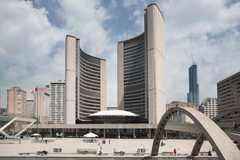Toronto City Hall / Toronto
City life
Although it was mayor Rob Ford’s controversial tenure that brought spectators to Toronto City Hall, the beauty of the modernist building shouldn’t be overlooked.
On a chilly spring afternoon outside Toronto City Hall, the city’s deputy mayor reads a proclamation as a flag is raised to mark International Day Against Homophobia and Transphobia. For the 100 or so councillors and onlookers gathered outside there is an odd feeling of relief for what is otherwise a fairly ceremonial event, as though to acknowledge the city itself has turned a corner.
Exactly one year before, for the same event, it was a distracted-looking mayor Rob Ford doing the raising and reading. This was just a few days after the news that a video existed showing the mayor smoking crack cocaine and using an anti-gay slur. Ford was photographed at the flag-raising standing alone, shunned by his colleagues. It was an awkward occasion and the beginning of the wildest ride in the city’s history. The mayor was eventually stripped of most of his powers.
Thanks to the ongoing Ford saga, Toronto City Hall has been the set for an astonishing real-life soap opera. And though embarrassed by Ford’s antics, Torontonians may have secretly taken a little pride in seeing their iconic City Hall, a local design landmark, so prominently on display. Completed in 1965, the futuristic building made an immediate impression, the composition of the site projecting a spirit of openness, optimism and civic engagement. Designed by Finnish architect Viljo Revell, its two curvaceous towers cradle a flying saucer-like structure housing the council chamber – often called “the clamshell” – that appears to hover above a two-storey plinth. The square in front is anchored by a large pool with sweeping concrete arches, a popular skating rink when it freezes over in winter, and is accented with a monumental sculpture by Henry Moore.
As the flag-raising ceremony disperses, councillors stick around to chat to the public. The gregarious Josh Matlow, a rookie councillor in his fourth year, seems to cherish moments like these when the building gets to play the part for which it was intended. Posing for a photograph in front of the east tower’s back wall – ribbed concrete vertical slabs textured with strips of Botticino marble – Matlow talks about how the building fosters an idea of open democracy and government.
“Once you enter City Hall you’re free to roam anywhere,” he says. “There is hardly any security. You can go to any committee room or the council chamber and watch everything. You can put up your hand and have five minutes to speak to the councillors.”
The building reflects life in the city, adds Matlow. “Unlike other government buildings, this is a community centre, a marriage chapel and an events centre. On any given morning I see people coming in to deal with an immigration issue or getting a licence renewed or a permit to film a movie. Then later I’ll see someone wearing a bridal gown. I’ll go outside and there will be a protest or a farmer’s market. You’re always feeling the vibe of Toronto within the corridors of this building.”
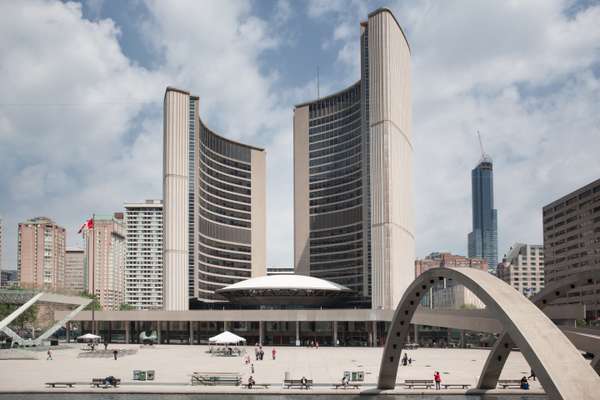
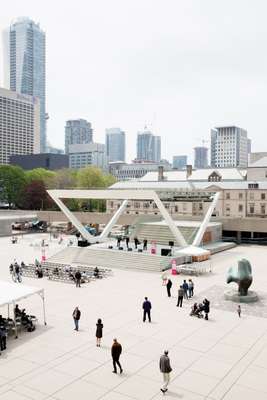
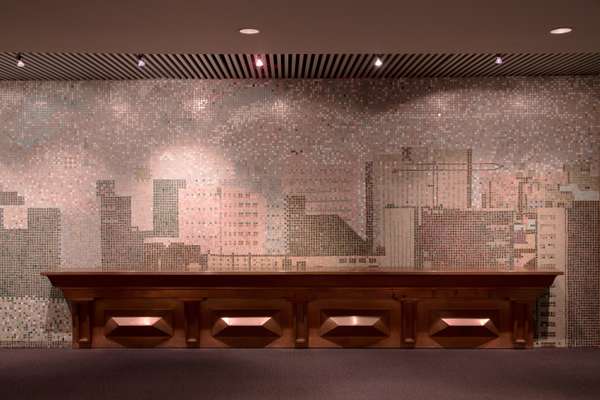

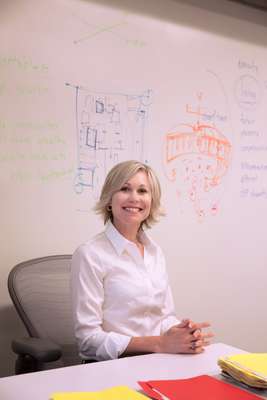
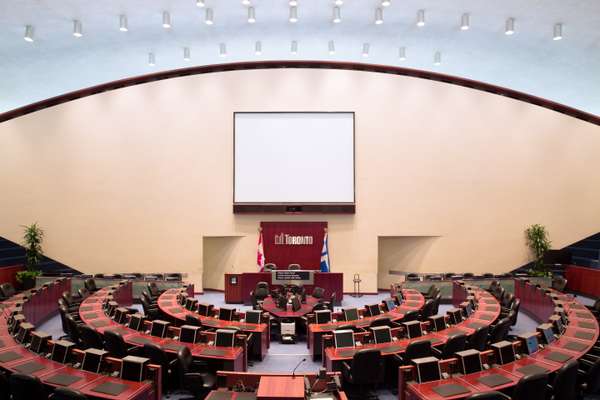
The new City Hall’s inauguration in 1965 signalled the birth of modern-day Toronto. As architecture and design critic Alex Bozikovic explains during a walk across the rooftop garden on the building’s plinth, Revell’s project broke ground for a new wave of sophisticated, large-scale developments in the city.
“Toronto was, at the time, on the cusp of changing from a fairly small, parochial and insular place to a city that was much more global, cosmopolitan and prosperous – much more interesting,” says Bozikovic. “I think this building helped bring about the transformation.”
How Toronto even arrived at the design by Revell, who died a year before the building’s completion, marked a turning point for the city. When a blueprint for a new City Hall by three local firms was rejected by citizens in a referendum, then-mayor Nathan Phillips called for an international design competition. The effect, Bozikovic says, would be to “change the character of the city by turning the design world’s attention to this backwater of a place”.
Revell’s winning design – highly symbolic and avant-garde – helped legitimise modern architecture in the city even if people’s tastes weren’t entirely ready for it. Before too long the novelty wore off and Torontonians’ ambivalence towards the building began to show. The site suffered from benign neglect and poorly considered modifications, especially within the public square. “It wasn’t treated as the sacred civic space it was designed to be,” says Bozikovic. “City workers just used to store equipment there. Things were installed willy-nilly.”
Fortunately that attitude toward City Hall has changed, in step with Toronto’s growing international profile and sense of confidence. Over the past decade locals have embraced Revell’s building as the symbol of their city, recognising it as Toronto’s one truly iconic piece of architecture and making the public square its living room. You can think of today’s prosperous, multi-ethnic Toronto, boasting more foreign-born residents than any other Canadian city, as a fulfilment of the values Revell hoped to project.
Yet, as futuristic as the building still appears, the philosophy behind it also reflects a particular era of 20th-century high-modernist design: one whose preoccupations with particular materials and symbols didn’t always produce amenable work and living spaces. It’s something Jennifer Keesmaat, the city’s chief planner, became acutely aware of when she began her job on the 12th floor of the east tower two years ago.
“It’s a modernist building but working inside it now I have a much more post-modern assessment,” says Keesmaat. “There are no windows on the back sides of the towers because everything was intended to focus on the clamshell where the democratic process happens. There are no obvious back doors so you can’t sneak out. This was intended as a metaphor for the strength of democracy.”
But there are down sides to this approach, Keesmaat adds. “What happens when you have a bureaucracy that can’t look out into the city? What is meant to be a powerful symbol can quickly be inverted to be about a place that is enclosed and contained and doesn’t have a vision beyond its own four walls.”
In other ways, Keesmaat suggests, Revell’s design was ahead of its time but the interventions made over the years have compromised some of the building’s integrity. Walls were put up and spaces divvied up into cubicles. Much of the building’s original mid-century modernist furniture has fallen into disrepair; surviving pieces are prized among staff. “Before, you would step off the elevator and get this tremendous view of the city through the glass with the other tower facing you,” Keesmaat recalls. “Now there are all these cubicles.”
Keesmaat is leading a pilot project on the 21st floor of the east tower to restore Revell’s open design concept, where she will eventually relocate her transit-planning team. “All the cubicles are being removed. When I actually see the space empty I realise I really get this building.”
At the time of writing, mayor Ford is on leave of absence at an in-patient rehab programme; the world’s cameras are absent. As this year’s flag-raising ceremony for the anti-homophobia day showed, life at City Hall is returning to something like normal. But it’s a tentative normal as most expect Ford will eventually return to resume his re-election bid.
Few are betting that he will win again but no one is counting him out, either. Nonetheless, Matlow says the atmosphere and political dynamics at City Hall have already moved post-Ford. As the mayor’s world unravelled, each denial or apology undermined by the next outrageous revelation or offensive sound bite, his allies on council began to peel away and strike a more independent position on issues. The intense polarisation that Ford had instilled in the culture of City Hall began to dissipate. What emerged in its place was a renewed sense of collegiality among councillors from across the political spectrum, united at least in the notion that serious city business shouldn’t be derailed by a “sideshow mayor”.
“It’s so interesting to be in this building now,” says Matlow. “I still get excited coming in every day. Maybe it doesn’t have the same sense of grandeur that older civic buildings do: it doesn’t have the stone, brick and wood. But it looks contemporary and symbolises the aspirations of a young, fledgling metropolis, making it a perfect design for Toronto. In terms of cities, Toronto is really a teenager.” Which brings Matlow full circle to what’s brought all this notoriety to Toronto City. “And there’s the thing,” he says. “Teenagers get in trouble.”

